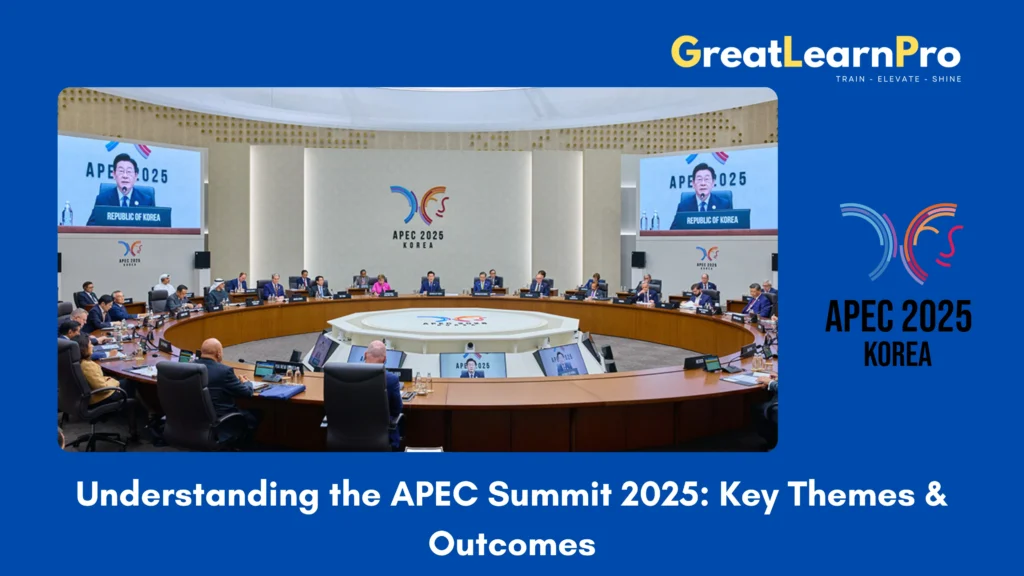Every year, the 21-member region of the Asia-Pacific gathers for the APEC Summit a forum that carries significant weight in global trade, investment, and economic cooperation. Established in 1989, APEC (Asia-Pacific Economic Cooperation) comprises economies that together account for a substantial portion of global GDP and trade.

Origins and Purpose
APEC was created in response to the growing interdependence of economies around the Pacific Rim and the need for a regional forum that could promote trade liberalisation, investment flows, and economic and technical cooperation.
The forum emphasises a few key objectives:
- Deepening regional economic integration.
- Liberalising trade and investment, and facilitating business activities across borders.
- Promoting inclusive, sustainable growth, and addressing issues like disaster resilience, climate change, and technological transformation.
A distinctive feature of APEC is that its decisions are non-binding and made by consensus meaning that while it can set agendas and shape dialogue, it lacks the enforcement power of treaties.
Membership and Structure
Today APEC has 21 member “economies” (the term emphasises participation in an economic forum rather than strictly national states).
These include many of Asia-Pacific’s major players: Australia, Canada, China, Japan, the United States, South Korea, Mexico, Indonesia, and others.
The annual summit of “economic leaders” (heads of government or heads of state) is the culmination of a year’s worth of ministerial and working-group meetings, and typically sets the broad direction of cooperation among the member economies.
Key Themes and Relevance
Given the breadth of the region covered by APEC and the share of global trade and output its members represent, what happens at the summit often reflects and helps influence global economic trends.
Recent summits have emphasised:
- Supply chain resilience, especially in the post-COVID period.
- Technological change, digitalisation, and innovation as drivers of growth.
- Sustainability and climate challenges, recognising that economic growth must align with environmental goals.
- Inclusive growth, recognising that participation of women, smaller economies, and less-developed sectors is essential. For instance, APEC’s Women and the Economy Forum is aimed at boosting women’s economic participation.
The 2025 Summit – A Snapshot
The latest iteration of APEC was hosted by Gyeongju, South Korea from October 31 to November 1, 2025 under the theme “Building a Sustainable Tomorrow: Connect, Innovate, Prosper.”
As host, South Korea sought to steer discussions toward pressing regional issues such as artificial intelligence, demographic change (aging populations and low birth-rates), and innovation. South Korea’s President highlighted the “APEC AI Initiative” as a key outcome of the summit.
From a geopolitical and economic perspective, the 2025 summit also comes amid heightened global uncertainty: protectionist sentiments, U.S.–China strategic competition, supply–chain realignment, and post-pandemic recovery pressures.
What’s at Stake for India and the Region
Although India is not a member of APEC, the decisions and agreements made at the summit influence the regional economic environment in which India operates—particularly as global supply chains shift, new digital and trade regimes emerge, and regional economic integration intensifies.
For member economies (and aspiring partners), the summit offers:
- A platform for bilateral and multilateral engagements side-by-side with the main event.
- An opportunity to influence the agenda for trade, investment, and innovation across the Asia-Pacific.
- Visibility for national priorities, such as technological advancement, sustainability initiatives, and export promotion.
Challenges and Critiques
While APEC convenes major economies and establishes forward-looking agendas, it is not without its limitations:
- Its commitments are voluntary, and decisions are made by consensus, which can slow action or produce relatively weak outcomes.
- The region faces structural shifts rising protectionism, fragmentation of technology regimes, and geopolitical rivalry that strain the liberal trade-and-investment framework APEC espouses.
- For smaller economies, translating summit declarations into concrete national-level reforms remains a long-term process.
Looking Ahead
The next APEC summit is scheduled to be hosted by Shenzhen, China, in 2026. As the region enters an era marked by rapid technological change, shifting trade patterns, and mounting environmental pressures, APEC’s relevance may hinge on how well it can evolve from setting broad goals toward facilitating concrete cooperation particularly in areas like AI, digital trade, sustainable infrastructure, and supply-chain diversification.
For India and other non-member economies, staying attuned to APEC’s agenda and engaging through dialogues and partnerships can provide strategic value in a world where trade and investment flows increasingly pivot to the Asia-Pacific.
Conclusion
The APEC Summit remains a key annual event in the Asia-Pacific’s economic diplomacy calendar. While it may not carry the binding force of some trade treaties, its role as a forum for dialogue, cooperation, and agenda-setting is crucial. As global economic and strategic winds shift, the work done under APEC’s umbrella around connectivity, innovation, and prosperity may well shape the contours of regional growth for years to come.
Sources:
- https://www.reuters.com/world/china/south-koreas-lee-hopes-tackle-ai-demographic-issues-apec-summit-2025-11-01/?utm_
- https://www.theguardian.com/world/2025/oct/31/era-of-free-trade-and-investment-over-canada-pm-mark-carney-apec-summit-korea?utm_
